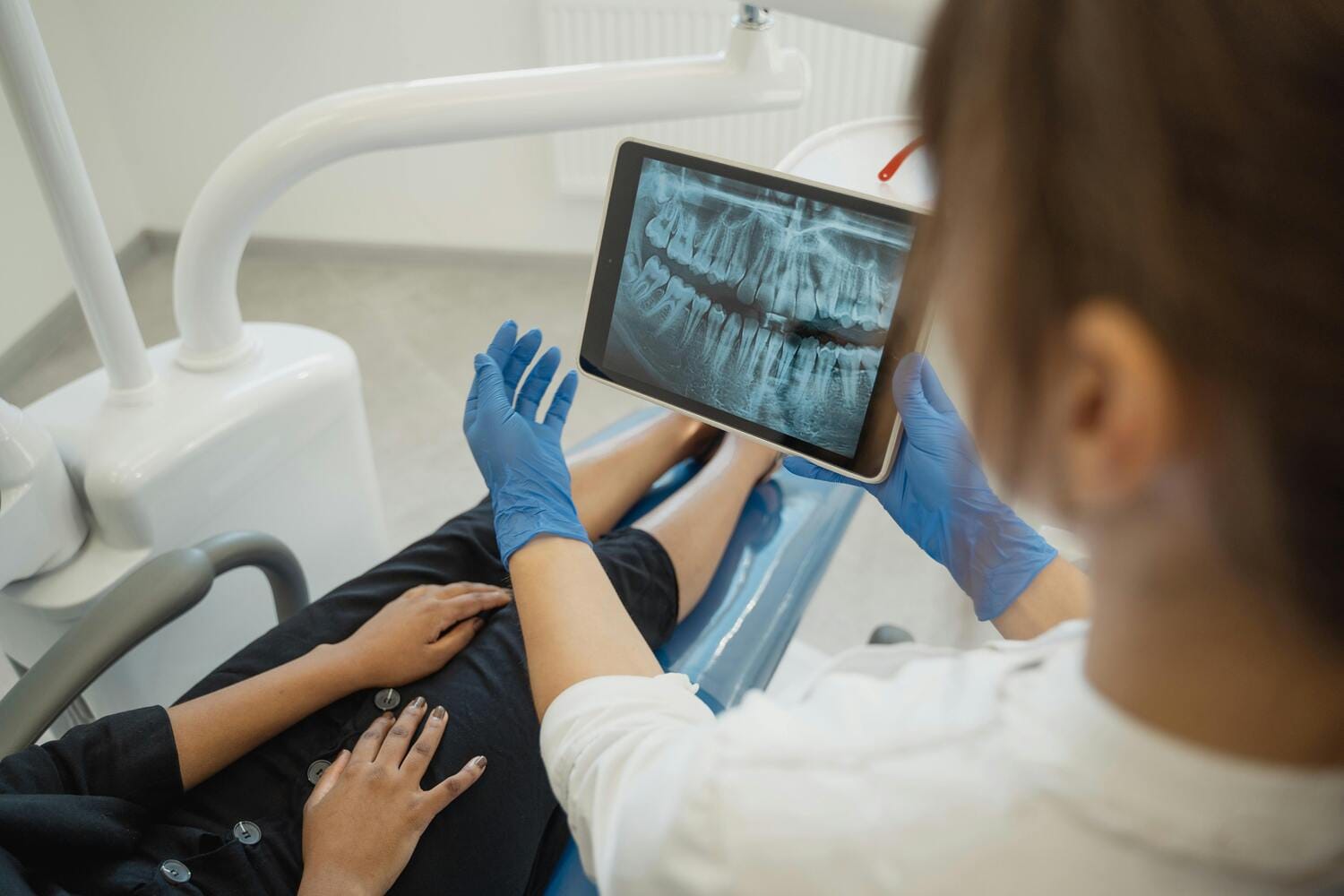Radiation in Dentistry and Safe Use of X-rays
X-rays are used daily by dentists and no doubt you will have experienced one or two during your visits. But we know some of you have questions about why we use them, particularly because of the radiation involved. We’ve put this article together to answer your questions and hopefully ease your worry, as well as looking at some new technologies in dental imagery.


Why Are X-Rays Used in Dentistry?
Dental X-rays help reveal issues that we can’t see with the naked eye, such as cavities that need filling, tooth fractures, infections, abscesses or impacted teeth, and can also track changes over time to help with treatment planning.
They work by sending a small dose of radiation to the targeted area – your teeth and jaw. Bones and teeth absorb more radiation than soft tissue, which is why they appear white on the X-ray images. Areas like gums and cheeks absorb less radiation and so appear darker. We then look at the digital image and can see which areas have hidden problems and need more investigation or intervention.
Radiation Exposure: How Much Is Too Much?
Radiation exposure in dental X-rays is extremely low compared to medical CT scans or chest X-rays. To put it in perspective:
- A single dental X-ray = 0.005 mSv (millisieverts)
- A chest X-ray = 0.1 mSv
- Natural background radiation (annually) = 2.4 mSv
For most people, routine dental X-rays pose minimal risk as they contribute only a fraction of annual radiation exposure. We do take precautions for certain groups of people, but most of our patients face little risk. In fact, a single X-ray emits less radiation than a short flight. Even bearing in mind this low emission, we’re still aware that radiation exposure is cumulative over a lifetime, and so only recommend X-rays when truly necessary.
You might wonder why dentists and staff step outside the room while an X-ray is being done. This is because we perform several X-rays every day and would otherwise be exposed to far more radiation than advised.
Radiation Safety for Dentists
Dentistry follows the ALARA (As Low As Reasonably Achievable) principle to minimise exposure for everyone:
- We only take X-rays if necessary – no overuse
- Digital X-rays reduce radiation by 80% – 90% compared to traditional film
- Lead aprons & thyroid collars protect vital organs from stray radiation
- We use collimated beams – those small cameras positioned next to your cheek – to focus X-rays precisely, avoiding unnecessary exposure.
Dental X-Rays for Children & Pregnant Patients
Dental X-rays are safe for children as they use even less radiation than a standard X-ray. Even so, we only X-ray children’s teeth if we need to keep an eye on potential cavities, to monitor growth or for orthodontic planning. We always keep such X-rays to an absolute minimum. If a parent or adult needs to be in the room with a child, we offer lead aprons for precautionary protection.
In the case of pregnant patients, we would generally avoid X-rays altogether, but if needed, for an emergency diagnosis, for example, a lead apron will protect both mother and baby.
Are There Alternatives to X-ray?
Dental imaging is evolving rapidly. The latest technology brings greater precision, lower radiation exposure and improved diagnostics. Here are some of the latest advancements:
- Artificial Intelligence (AI) in Imaging
AI is popping up in all areas of our lives and that includes in dentistry. It’s revolutionising dental diagnostics by automating image analysis, detecting abnormalities and helping with treatment planning. AI-powered software can highlight potential issues like cavities or bone loss, which improves accuracy and efficiency of the treatment.
- Cone Beam Computed Tomography (CBCT)
CBCT provides high-resolution 3D imaging, so dentists can visualise teeth, nerves and bone structures in incredible detail. This is particularly useful when we’re planning implants and for orthodontics and complex surgeries.
- Intraoral Scanners & Cameras
These are handheld devices that capture real-time, high-definition images inside your mouth, so we don’t need to use messy and uncomfortable putty and moulds. They’re far more pleasant for you and improve diagnostic precision for us.
- Augmented Reality (AR) & Virtual Reality (VR)
AR and VR are being integrated into dental imaging for treatment simulations and patient education. We can use AR overlays to visualise procedures before performing them, which not only improves the accuracy of treatment, but lets you see what will be happening.
- Digital Volume Tomography (DVT)
DVT offers exceptionally high-resolution 3D imaging, refining the CBCT capabilities mentioned above for an even greater detailed analysis of dental structures. This is particularly beneficial for complex cases that need precise anatomical assessment.
- AI-Powered Facial Scanning
New AI-driven facial scanners capture realistic, high-resolution images without radiation exposure – perhaps marking the beginning of the end of X-rays as we know them. At the moment, these are used for orthodontic planning and aesthetic treatments, giving patients personalised care.
- 3D Printing & Scanning
The labs we work with have adopted advanced 3D scanning and printing technologies. That means we can produce precise digital impressions, which can be used for custom prosthetics, crowns and aligners. This speeds up treatment and enhances accuracy.
These innovations are reshaping dental diagnostics and treatment planning, making procedures more efficient and patient-friendly. Whilst we don’t currently use them all at Holland Park Dental Centre – apart from 3D printing and scanning – we are advocates of embracing technology to make your dental experience as comfortable as possible.
If you have any questions about how and when we use X-rays, or any other dental questions – and to book an appointment – please contact us today.

Sorry, the comment form is closed at this time.